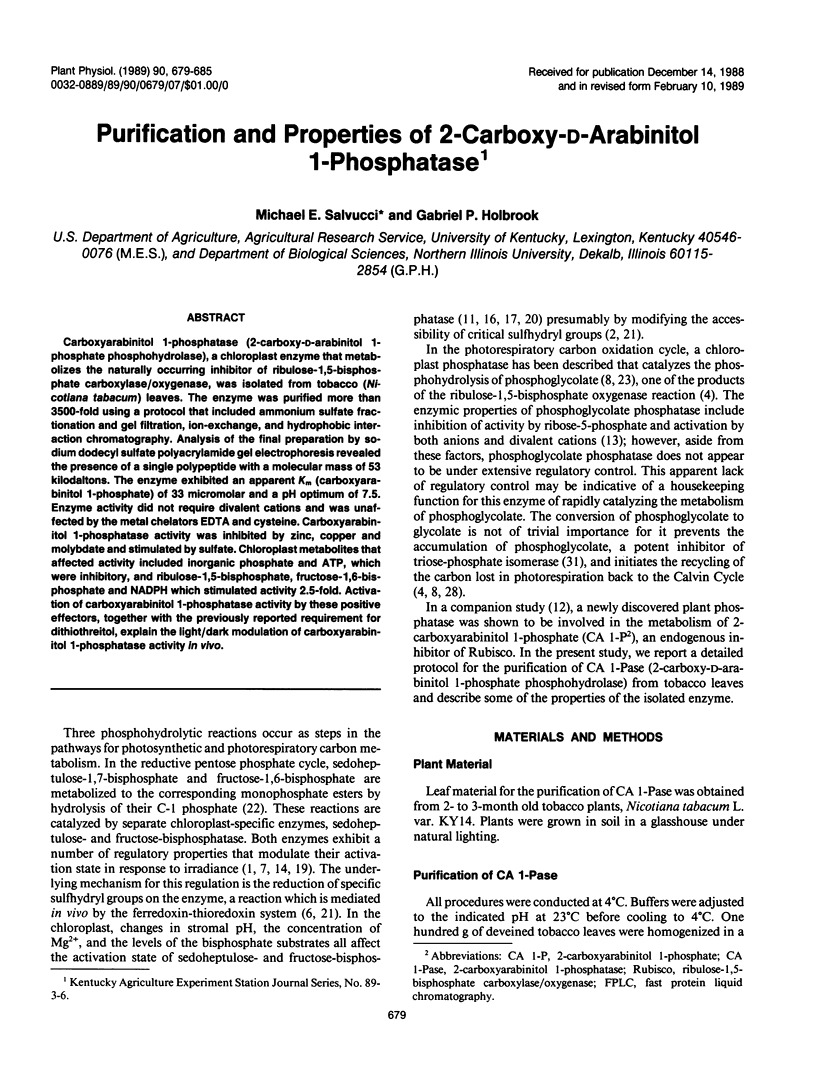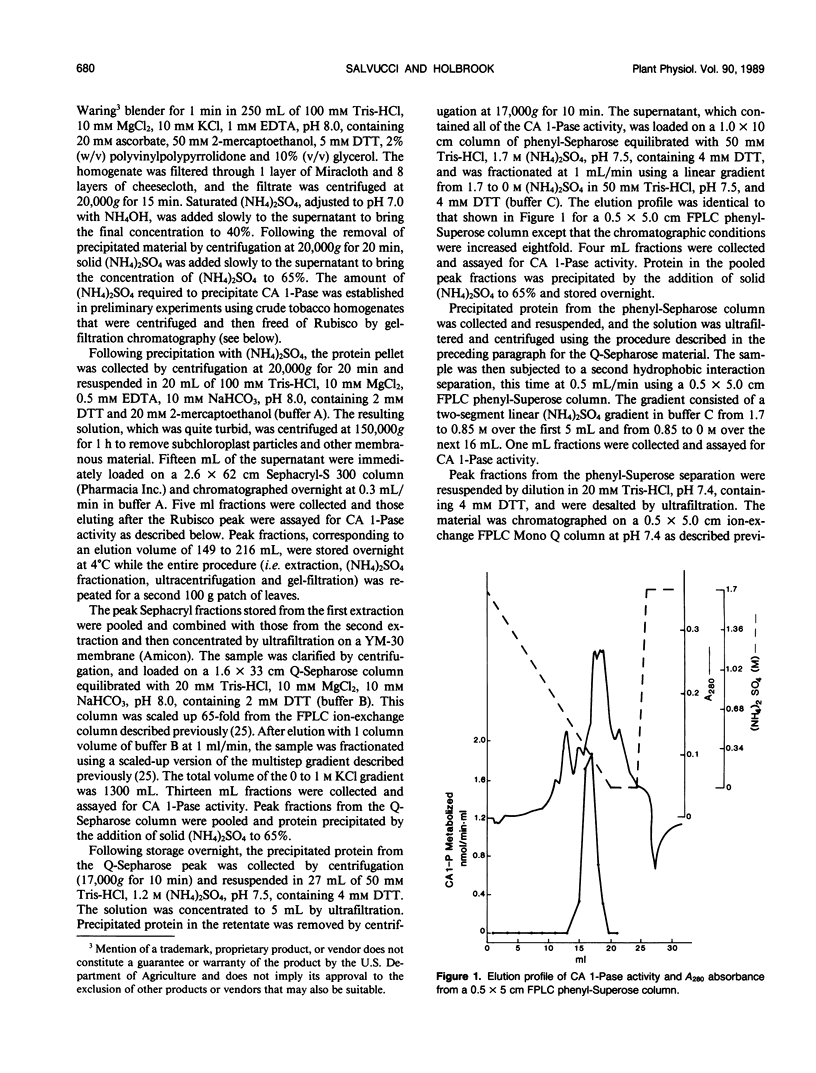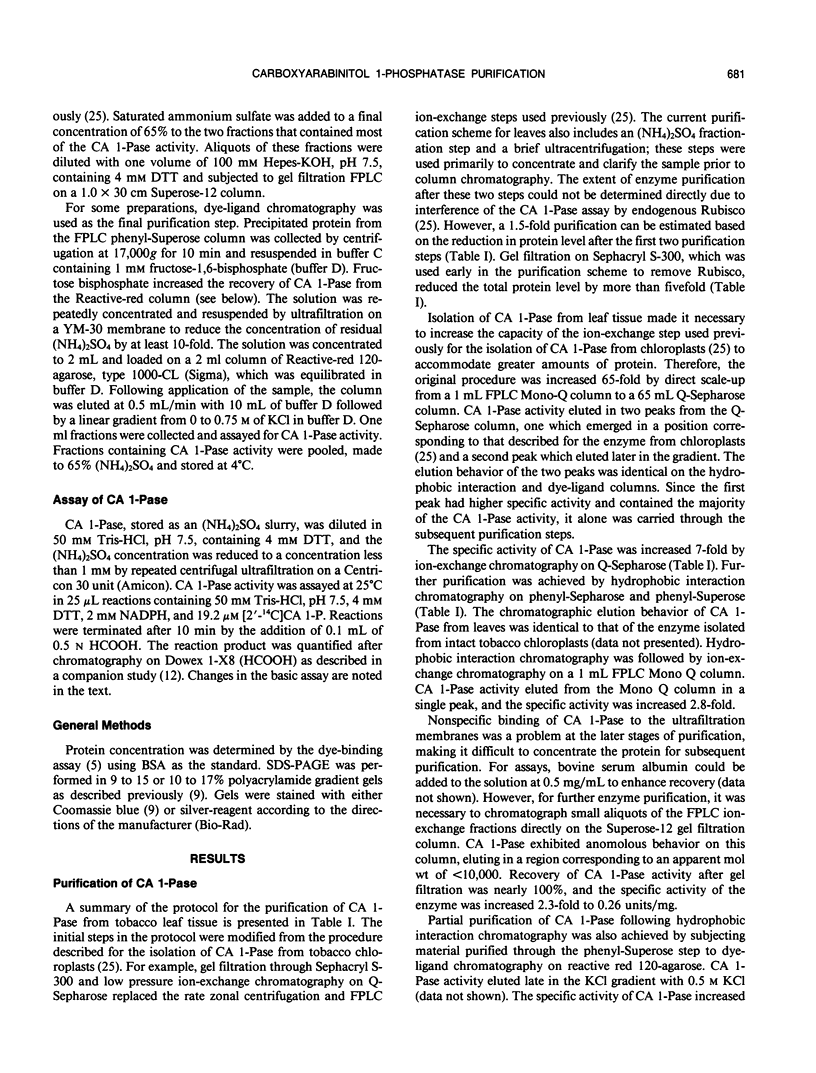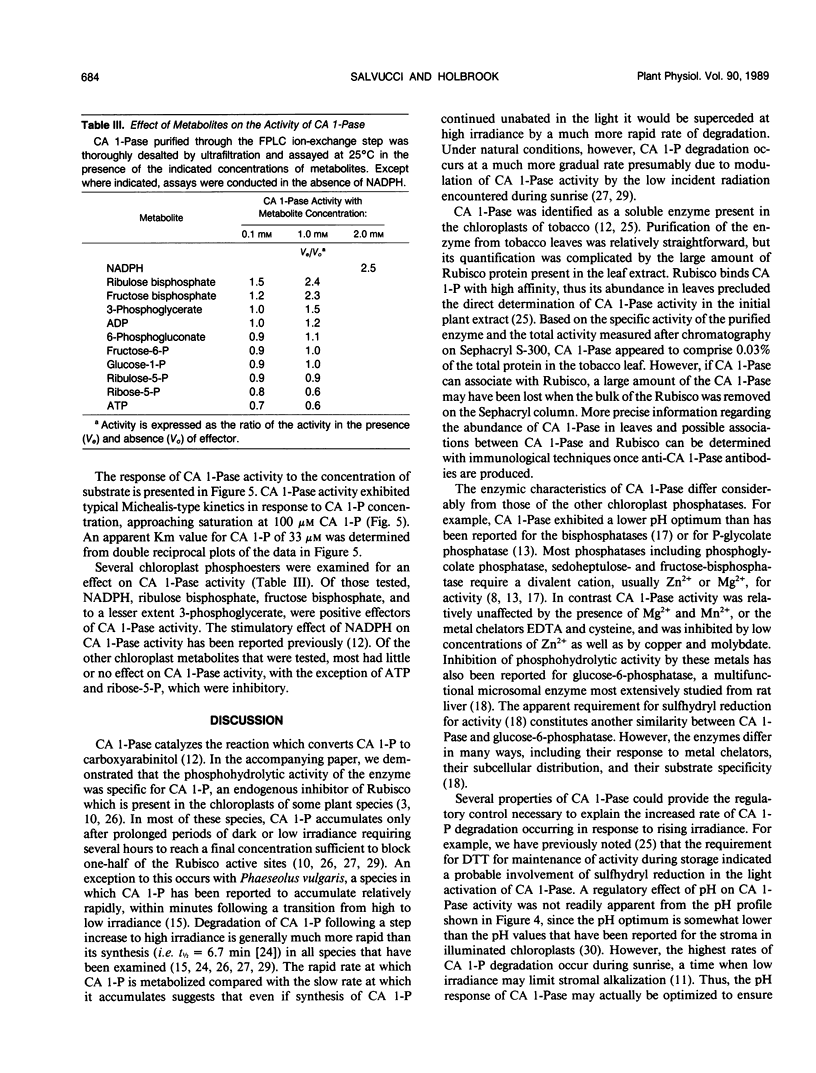Abstract
Carboxyarabinitol 1-phosphatase (2-carboxy-d-arabinitol 1-phosphate phosphohydrolase), a chloroplast enzyme that metabolizes the naturally occurring inhibitor of ribulose-1,5-bisphosphate carboxylase/oxygenase, was isolated from tobacco (Nicotiana tabacum) leaves. The enzyme was purified more than 3500-fold using a protocol that included ammonium sulfate fractionation and gel filtration, ion-exchange, and hydrophobic interaction chromatography. Analysis of the final preparation by sodium dodecyl sulfate polyacrylamide gel electrophoresis revealed the presence of a single polypeptide with a molecular mass of 53 kilodaltons. The enzyme exhibited an apparent Km (carboxyarabinitol 1-phosphate) of 33 micromolar and a pH optimum of 7.5. Enzyme activity did not require divalent cations and was unaffected by the metal chelators EDTA and cysteine. Carboxyarabinitol 1-phosphatase activity was inhibited by zinc, copper and molybdate and stimulated by sulfate. Chloroplast metabolites that affected activity included inorganic phosphate and ATP, which were inhibitory, and ribulose-1,5-bisphosphate, fructose-1,6-bisphosphate and NADPH which stimulated activity 2.5-fold. Activation of carboxyarabinitol 1-phosphatase activity by these positive effectors, together with the previously reported requirement for dithiothreitol, explain the light/dark modulation of carboxyarabinitol 1-phosphatase activity in vivo.
Full text
PDF






Images in this article
Selected References
These references are in PubMed. This may not be the complete list of references from this article.
- Anderson L. E. Activation of pea leaf chloroplast sedoheptulose 1,7-diphosphate phosphatase by light and dithiothreitol. Biochem Biophys Res Commun. 1974 Aug 5;59(3):907–913. doi: 10.1016/s0006-291x(74)80065-3. [DOI] [PubMed] [Google Scholar]
- Berry J. A., Lorimer G. H., Pierce J., Seemann J. R., Meek J., Freas S. Isolation, identification, and synthesis of 2-carboxyarabinitol 1-phosphate, a diurnal regulator of ribulose-bisphosphate carboxylase activity. Proc Natl Acad Sci U S A. 1987 Feb;84(3):734–738. doi: 10.1073/pnas.84.3.734. [DOI] [PMC free article] [PubMed] [Google Scholar]
- Bowes G., Ogren W. L., Hageman R. H. Phosphoglycolate production catalyzed by ribulose diphosphate carboxylase. Biochem Biophys Res Commun. 1971 Nov 5;45(3):716–722. doi: 10.1016/0006-291x(71)90475-x. [DOI] [PubMed] [Google Scholar]
- Bradford M. M. A rapid and sensitive method for the quantitation of microgram quantities of protein utilizing the principle of protein-dye binding. Anal Biochem. 1976 May 7;72:248–254. doi: 10.1016/0003-2697(76)90527-3. [DOI] [PubMed] [Google Scholar]
- Christeller J. T., Tolbert N. E. Phosphoglycolate phosphatase. Purification and properties. J Biol Chem. 1978 Mar 25;253(6):1780–1785. [PubMed] [Google Scholar]
- Holbrook G. P., Bowes G., Salvucci M. E. Degradation of 2-carboxyarabinitol 1-phosphate by a specific chloroplast phosphatase. Plant Physiol. 1989 Jun;90(2):673–678. doi: 10.1104/pp.90.2.673. [DOI] [PMC free article] [PubMed] [Google Scholar]
- Husic H. D., Tolbert N. E. Anion and divalent cation activation of phosphoglycolate phosphatase from leaves. Arch Biochem Biophys. 1984 Feb 15;229(1):64–72. doi: 10.1016/0003-9861(84)90130-9. [DOI] [PubMed] [Google Scholar]
- Kelly G. J., Zimmermann G., Latzko E. Light induced activation of fructose-1, 6-bisphosphatase in isolated intact chloroplasts. Biochem Biophys Res Commun. 1976 May 3;70(1):193–199. doi: 10.1016/0006-291x(76)91127-x. [DOI] [PubMed] [Google Scholar]
- Portis A. R., Jr, Chon C. J., Mosbach A., Heldt H. W. Fructose-and sedoheptulosebisphosphatase. The sites of a possible control of CO2 fixation by lightdependent changes of the stromal Mg2+ concentration. Biochim Biophys Acta. 1977 Aug 10;461(2):313–325. doi: 10.1016/0005-2728(77)90181-5. [DOI] [PubMed] [Google Scholar]
- Pradel J., Soulié J. M., Buc J., Meunier J. C., Ricard J. On the activation of fructose-1,6-bisphosphatase of spinach chloroplasts and the regulation of the Calvin cycle. Eur J Biochem. 1981 Jan;113(3):507–511. doi: 10.1111/j.1432-1033.1981.tb05092.x. [DOI] [PubMed] [Google Scholar]
- RACKER E., SCHROEDER E. A. The reductive pentose phosphate cycle. II. Specific C-1 phosphatases for fructose 1,6-diphosphate and sedoheptulose 1,7-diphosphate. Arch Biochem Biophys. 1958 Apr;74(2):326–344. doi: 10.1016/0003-9861(58)90004-3. [DOI] [PubMed] [Google Scholar]
- RICHARDSON K. E., TOLBERT N. E. Phosphoglycolic acid phosphatase. J Biol Chem. 1961 May;236:1285–1290. [PubMed] [Google Scholar]
- Salvucci M. E., Anderson J. C. Factors affecting the activation state and the level of total activity of ribulose bisphosphate carboxylase in tobacco protoplasts. Plant Physiol. 1987 Sep;85(1):66–71. doi: 10.1104/pp.85.1.66. [DOI] [PMC free article] [PubMed] [Google Scholar]
- Seemann J. R., Berry J. A., Freas S. M., Krump M. A. Regulation of ribulose bisphosphate carboxylase activity in vivo by a light-modulated inhibitor of catalysis. Proc Natl Acad Sci U S A. 1985 Dec;82(23):8024–8028. doi: 10.1073/pnas.82.23.8024. [DOI] [PMC free article] [PubMed] [Google Scholar]
- Vu C. V., Allen L. H., Bowes G. Effects of Light and Elevated Atmospheric CO(2) on the Ribulose Bisphosphate Carboxylase Activity and Ribulose Bisphosphate Level of Soybean Leaves. Plant Physiol. 1983 Nov;73(3):729–734. doi: 10.1104/pp.73.3.729. [DOI] [PMC free article] [PubMed] [Google Scholar]
- Werdan K., Heldt H. W., Milovancev M. The role of pH in the regulation of carbon fixation in the chloroplast stroma. Studies on CO2 fixation in the light and dark. Biochim Biophys Acta. 1975 Aug 11;396(2):276–292. doi: 10.1016/0005-2728(75)90041-9. [DOI] [PubMed] [Google Scholar]
- Wolfenden R. Binding of substrate and transition state analog to trisephosphate isomerase. Biochemistry. 1970 Aug 18;9(17):3404–3407. doi: 10.1021/bi00819a018. [DOI] [PubMed] [Google Scholar]



